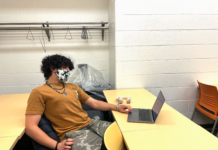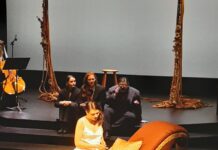A new collective is working to transform the Waterloo region art scene from the ground up. Tri-City Stopgap, founded by Michael Jacob Ambedian, Nadine Badran, and Sheila McMath, is holding its first exhibition in a candy-factory-turned-gallery-space. A non-juried, open call art show, Tri-City Stopgap’s first initiative is focused around creating an alternative environment for artists outside of traditional commercial venues.
Operating on a foundational level, the exhibit is an opportunity for artists at all levels to show their work, develop confidence, and build their credentials.
“Our collaborative venture has been motivated by a desire to create a stronger grassroots arts community, and provide this region with multiple opportunities for informal, experimental exchange among artists and the larger community,” Tri-City Stopgap said in an email response.
Tri-City Stopgap is poised to provide a foundation for local artist-run initiatives, emphasizing a postmodern inclusivity which largely benefits the artists they collaborate with. With no fee to hang art, no percentage taken from the sale of the work during the show, and no limit on the artwork displayed, the pop-up exhibit acts as a desirable platform for artists of all backgrounds.
The show itself is a smorgasbord of media and subject matter, as multiple pieces from each of the 64 artists are displayed throughout the industrial factory space. A wide range of themes are explored in the works, rendered as drawings, paintings, sculpture, printmaking, photography, digital media, installation art, and interactive art.
The sheer size of the gallery space itself is impressive, allowing the works of both emerging and established artists to co-exist without feeling claustrophobic. Complementing both the quantity and scale of the works it houses, the space boasts a number of large scale installations and interactive pieces. Each room invites exploration, and the works are curated to both satisfy and elicit curiosity.
The main antechamber, a converted warehouse floor, hosts a collection of massive installation and sculptural works, such as Ann Marie Hadcock’s room-length <em>Wavelengths</em>, and Sandra Dunn’s ominous <em>Feast or Famine.</em> Works made up of various unconventional materials reside throughout the other nooks and crannies of the space, such as Meg Harder’s mixed media installation <em>Debris Hut,</em> a life-sized tipi made of natural branches and numerous piles of leaves, and the writhing foam and epoxy resin forms of Rick Nixon’s <em>Frayed Wall. </em>
Another of the show’s particular strengths is the quality of the photographic works on display. Kasia Dunn’s <em>Women in Nature </em>series evoke an intimate counterbalance to the stark, architectural explorations of Jim Blomfield’s <em>Forever </em>series found in the same room.
Tri-City Stopgap is also successful in its offerings of more traditional media. Acrylic and oil based, numerous paintings of all sizes and styles were one of the most attractive focal points of the exhibition, both in their frequency and level of execution. Notable works of this type include Vickie Vainionpaa’s <em>The Way,</em> mixing cloudlike forms with geometric abstractions, David G. White’s <em>Checkpoint,</em> which superimposes narratives of realistic human struggle over striking optical illusions, and Melissa Doherty’s <em>Hover,</em> a dreamlike piece reminiscent of portals and utopic natural landscapes.
Following the conclusion of this show, Tri-City Stopgap intends on continuing their work to expand the local art scene through various artist-run initiatives. Tri-City Stopgap’s show is open from 4:30-8:30 p.m. Oct. 25-31 at 151 Weber St S., with a reception Nov. 1 from 7 p.m. to 2 a.m.






























